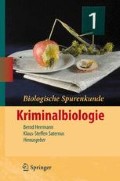Access this chapter
Tax calculation will be finalised at checkout
Purchases are for personal use only
Preview
Unable to display preview. Download preview PDF.
Literatur
Albrecht K, Schultheiss D, Rothämel T, Breitmeier D, Tröger HD (2004) Der Nachweis von Spermaspuren in der forensischen Medizin. Kriminaltechnik 8–9:552–558
Anleitung des Hexagon OBTI-Testes, Rolf Greiner BioChemica
Balding D, Donnelly P (1996) Evaluating DNA profiles evidence when the suspect is identified through a database search. J Forensic Sci 41:603–607
Bauer H (1937) Das Glykogen in den Plattenepithelien der Harn-und Geschlechtswege und seine forensische Bedeutung, untersucht an menschlichem und tierischem Material. MED-Diss, Würzburg
Berg SP (1954) Methoden zum Nachweis von Genitalsekretspuren. Dtsch Z Gerichtl Med 42:605–613
Brinkmann B, Madea B, Rand S (1985) Charakterisierung von Mikroblutspuren. Z Rechtsmed 94:237
Brinkmann B, Madea B, Rand S (1986) Zu den Einflussfaktoren auf die Morphologie der Blutspur. Beitr Gerichtl Med 44:67
Brüning A (1957) Nachweis von Blut in Blutflecken. In: Ponsold’s Lehrbuch der Gerichtlichen Medizin. Thieme, Stuttgart
Dietz G (1967) Spermaspuren. In: Dietz G (Hrsg) Gerichtliche Medizin für Juristen, Kriminalisten, Studierende der Rechtswissenschaften und Medizin. Barth, Leipzig, S 220
Dikti A (1999) Blutspuren. Kriminalistik 4:266–268
Hansen G (1954) Untersuchung von Spermaflecken. In: Hansen G (Hrsg) Gerichtliche Medizin. Thieme, Leipzig, S 210
Hauck G, Leithoff H (1959) Phosphatase als gerichtsmedizinischer Spermanachweis. Dtsch Z ges Gerichtl Med 49:5
Hausmann R, Pregler C, Schellmann B (1994) The value of the Lugol’s iodine staining technique for the identification of vaginal epithelial cells. Int J Leg Med 106:298–301
Hausmann R, Schellmann B (1994) Forensic value of the Lugol’s staining method: further studies on glycogenated epitheliumin the male urinary tract. Int J LegMed 107:147–151
Holzer F (1940) Scheidensekret. In: Neureiter F v, Pietrusky F, Schütt E (Hrsg) Handwörterbuch der Gerichtlichen Medizin und Naturwissenschaftlichen Kriminalistik. Springer, Berlin Heidelberg New York, S 633
Kaup L (1995) Form. In: Schleyer, Oepen, Henke (Hrsg) Humanbiologische Spuren. Kriminalistik-Verlag, Heidelberg, S 2
Kaye S (1950) The acid phosphatase test for seminal stains. J Crim Law 41:834–835
Killias M, Haas H, Taroni F, Margot P (2003) Welche Verurteilten müssen in einer DNA Profil-Datenbank erfasst werden? Crimescope 21:1–7
Kubelka A, Wolf H (1963) Der Nachweis von Blut im Stuhl usw. mit Luminol. Med Welt, S 1374
Lochte TH (1933) Über die Kronenbildung des auffallenden Bluttropfens und ihre Beziehungen zu sekundären Blutspritzern. Z gerichtl Med 22:387
Lochte TH (1938) Atlas der menschlichen und tierischen Haare. Schöps, Leipzig
Lundquist F (1950) Medicolegal identification of seminal stains using the acid phosphatase test. Arch Path 50:395–399
Merkel H (1924). Über den Glykogengehalt des Scheidenepithels, seine diagnostische Bedeutung und deren kritische Bewertung. Z Ges Gerichtl Med 4:1–8
Müller W (1971) Versuche über Empfindlichkeit und Spezifität der Luminolreaktion zum Blutnachweis. Diss. Marburg
Orfanos CE (1979) Haar und Haarkrankheiten. Fischer, Stuttgart New York
Piotrowski E (1895) Über Entstehung, Form, Richtung und Ausbreitung der Blutspuren. Virchows Jahresber I, Wien
Rand S, Madea B, Brinkmann B (1985) Zur Morphologie von Blutspuren. Beitr Gerichtl Med 43:259
Rijesfeld O (1946) Acid phosphatase employed as a new method of demonstrating seminal spots in forensic medicine. Acta Path Microbiol Scand 58:1–89
Rothwell TJ, Harvey KJ (1978) The limitation of the Lugol’s iodine staining technique for the identification of vaginal epithelial cells. J Forensic Sci 18:181–184
Schöneberg A, Gerl L, Oesterreich W, Bastisch I, Gerhard M, Kärgel H-J, Fesefeld A, Pflug W (2003) DNA-Analyse von Hautabriebspuren. Kriminalistik 8-9:497–499
Senge L (2005) Die Neuregelung der forensischen DNA-Analyse. NJW 42:3028–3033
Thomas F, Hecke W von (1963) The demonstration of recent sexual intercourse in the male by Lugol method. Med Sci Law 3:169–171
Tröger HD, Eisenmenger W (1977) Eine Methode zum Nachweis von Scheidenepithelien. Beitr Gerichtl Med 35:109–111
Volk E (2002) DNA-Identitätsfeststellungsgesetz — Kein Ende der Begehrlichkeiten. Neue Z f Strafr 11:561–616
Walcher K (1939) Gerichtlich-medizinische und kriminalistische Blutuntersuchungen. Springer, Berlin, S 15
Weber K (1966) Die Anwendung der Chemiluminescenz des Luminols I. Z gerichtl. Med 57:410
Wiegmann H (1910) Über den Glykogengehalt der Scheidenepithelienz und seine diagnostische Bedeutung. Med Diss, München
Author information
Authors and Affiliations
Editor information
Editors and Affiliations
Rights and permissions
Copyright information
© 2007 Springer-Verlag Berlin Heidelberg
About this chapter
Cite this chapter
Lassen, C., Kaup, L. (2007). Forensische Untersuchung von Blut- und Sekretspuren, Epithelzellspuren, Urin, Kotspuren, Haaren, Knochen, Zähnen sowie Vergleichsmaterial. In: Herrmann, B., Saternus, KS. (eds) Biologische Spurenkunde. Springer, Berlin, Heidelberg. https://doi.org/10.1007/978-3-540-71111-7_13
Download citation
DOI: https://doi.org/10.1007/978-3-540-71111-7_13
Publisher Name: Springer, Berlin, Heidelberg
Print ISBN: 978-3-540-71110-0
Online ISBN: 978-3-540-71111-7
eBook Packages: Medicine (German Language)

